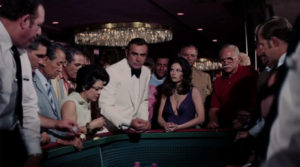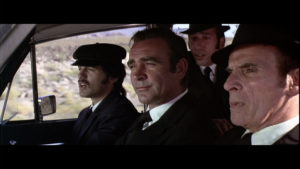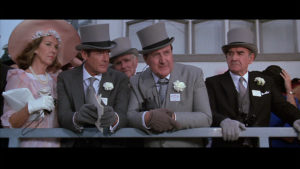By page 33 of Diamonds Are Forever, James Bond is already undercover as Peter Franks in an operation to disassemble an illegal diamond pipeline, having been briefed by M, and all with an opening chapter not even featuring the secret agent protagonist. Compared to the previous books in the series, its an incredibly fast-paced opening, blitzing through the set up to place Bond in danger as quickly as possible. Very much a book of three thirds, the first continues this breakneck pace, but while Diamonds Are Forever is an easy and fast read, it’s also vapid. Empty of much substance beyond the occasional hint at something deeper. Along with a plot very similar to that of Live and Let Die – the gold coins simply replaced with diamonds – it makes Ian Fleming’s fourth James Bond novel the most forgettable and weakest yet.
 While undercover, Bond contemplates on how this mission reminds him of his earlier work during the war, something he thought he’d moved away from and is haunted by the memories of. These are some intriguing teases for examining Bond more deeply as a character but they remain nothing but teases. Bond immediately drops his moniker of Peter Franks and decides to tell every villainous gangster he meets that his name is actually James Bond. He then, after doing little but drink and gamble his way across the Atlantic and America, mentions how he’s homesick for his old, real identity. This would be interesting if he was actually acting any different than usual but he’s not! He’s the same character whether he’s with his allies or enemies and it feels like a huge missed opportunity. I do like the passage where Bond decides he has to dismiss his own feelings however. He needs to act like a blunt weapon, the man who was only a silhouette, even if he is more than that.
While undercover, Bond contemplates on how this mission reminds him of his earlier work during the war, something he thought he’d moved away from and is haunted by the memories of. These are some intriguing teases for examining Bond more deeply as a character but they remain nothing but teases. Bond immediately drops his moniker of Peter Franks and decides to tell every villainous gangster he meets that his name is actually James Bond. He then, after doing little but drink and gamble his way across the Atlantic and America, mentions how he’s homesick for his old, real identity. This would be interesting if he was actually acting any different than usual but he’s not! He’s the same character whether he’s with his allies or enemies and it feels like a huge missed opportunity. I do like the passage where Bond decides he has to dismiss his own feelings however. He needs to act like a blunt weapon, the man who was only a silhouette, even if he is more than that.
Bond starts his mission in London but soon is tasked with smuggling diamonds into New York and unraveling the web of criminality that is the Spangled Mob, an American organised crime outfit, and determine who calls the shots. In his brief appearance, M is worried for Bond like never before and this feels very contrived. America is apparently wild and savage and everyone keeps reminding Bond that these gangsters are dangerous, even though they may not seem like it. Fleming wants to create tension and make the mob seem like Bond’s deadliest antagonist yet but even he can’t believe that for more than a few paragraphs and constantly undermines them. “These people were just teenage pillow-fantasies”, whatever that means.
 In a James Bond adventure I want a great, megalomaniacal villain with a fiendish plot and a memorable henchman, just like in Moonraker, but in Diamonds Are Forever we’re overloaded with gangsters whose characterisation begin and end with a silly name. Fleming wants to show the scale of the criminal operation but that means no single enemy stands out or makes an impression. As soon as one is introduced and seems interesting, another takes his place as Bond moves on. Our hero is up against some nebulous organisation; gangland aristocracy rather than a classic Bond villain. The Spang brothers are as close as the book comes, with Jack Spang in London posing as Rufus B. Saye and Seraffimo Spang in Las Vegas, but neither are memorable in the slightest.
In a James Bond adventure I want a great, megalomaniacal villain with a fiendish plot and a memorable henchman, just like in Moonraker, but in Diamonds Are Forever we’re overloaded with gangsters whose characterisation begin and end with a silly name. Fleming wants to show the scale of the criminal operation but that means no single enemy stands out or makes an impression. As soon as one is introduced and seems interesting, another takes his place as Bond moves on. Our hero is up against some nebulous organisation; gangland aristocracy rather than a classic Bond villain. The Spang brothers are as close as the book comes, with Jack Spang in London posing as Rufus B. Saye and Seraffimo Spang in Las Vegas, but neither are memorable in the slightest.
In New York Bond is confronted by the local leader of the Spangled Mob so just how will Bond handle such a tense interaction with his first threat of the novel? Well, it turns out the baddie is a hunchback with a squeaky voice called Michael ‘Shady’ Tree. And let’s not talk about his henchman ‘Lame Brain’ Pissaro. As for how Bond feels about ‘Shady’ Tree, “He was amused by the hunchback. There was something splendidly theatrical about him, and his vanity about the Spangled Mob was appealing.” Amusing, splendid, and appealing. Not exactly qualities I want Bond to find in his adversaries. It’s impossible to take most of the gangsters Fleming writes seriously and, despite the great set up, the book is without any tension in its first half.
 Thankfully, and somewhat surprisingly, the book fares better with its Bond woman, the American smuggler Tiffany Case. She’s immediately an interesting character and Fleming offers small details about her life which we can grab onto, like the music she listens to, which is more than most female characters have received thus far in the series. She’s fierce and speaks her mind in Fleming’s approximation of 1950’s American syntax; something outdated in an enjoyable way rather than the usual awkward way. Bond and Case’s interactions are a game and it’s fun being a spectator. He’s keeping up a lie, she a hardened front, and both want to be honest but can’t. It’s a shame then that Tiffany’s rare ‘Bond girl’ personality is formed from trauma. She switches moods in a bipolar fashion and refuses to sleep with men because she was gang raped at 16 in her mother’s cat house. Of course, Bond is able to ‘cure’ her of all this with his affection.
Thankfully, and somewhat surprisingly, the book fares better with its Bond woman, the American smuggler Tiffany Case. She’s immediately an interesting character and Fleming offers small details about her life which we can grab onto, like the music she listens to, which is more than most female characters have received thus far in the series. She’s fierce and speaks her mind in Fleming’s approximation of 1950’s American syntax; something outdated in an enjoyable way rather than the usual awkward way. Bond and Case’s interactions are a game and it’s fun being a spectator. He’s keeping up a lie, she a hardened front, and both want to be honest but can’t. It’s a shame then that Tiffany’s rare ‘Bond girl’ personality is formed from trauma. She switches moods in a bipolar fashion and refuses to sleep with men because she was gang raped at 16 in her mother’s cat house. Of course, Bond is able to ‘cure’ her of all this with his affection.
Diamonds Are Forever sees Fleming in a role as travel writer just as much as a thriller writer. Bond’s flights and airport visits are written like a review of BOAC, now British Airways, including the meals they serve and the comfort of the seats. This was a luxury most readers in post-war Britain couldn’t afford and no doubt the Succession-style wealth porn excited them as much as the gunplay. Once on American soil, Bond is swiftly reunited with Felix Leiter, now working as a Pinkerton rather than a CIA agent, but once again fills his welcome role as Bond’s guide to American life. The shark attack in Live and Let Die left him brutally mauled and he lost his right arm, left leg, and required a skin graft on his face. While the Bond movies still have a body fascism problem, it’s great to see Fleming’s heroic characters have physical differences rather than just the villains. Leiter has a prosthetic leg and a hook for a hand, and even Bond has a scar on his face, something I’d love to see in the next big screen incarnation.
 Bond, using his real name and joined by his friend, Felix Leiter, a known former CIA agent, now Pinkerton, with easily distinguishable physical features, visits the Saratoga horse racing track where the Spangled Gang operate, and yet somehow retains his cover as a smuggler and ally to the gangsters. The 50 pages spent at the race track, explaining how the mob cheat on races, are a total bore. It reminded me of the similar section of A View to a Kill, my least favourite part of any Bond film. Bond is completely passive, just watching the plot happen around him as Felix does his thing of scuppering the criminals’ plans by bribing a jockey to make sure he wins but is disqualified. It’s an elaborate way to lose, just like the card games in Casino Royale and Moonraker, but now with an unwanted layer of Dick Francis. It’s here where the previously fast pace grinds to a halt. The middle of the book is very dull.
Bond, using his real name and joined by his friend, Felix Leiter, a known former CIA agent, now Pinkerton, with easily distinguishable physical features, visits the Saratoga horse racing track where the Spangled Gang operate, and yet somehow retains his cover as a smuggler and ally to the gangsters. The 50 pages spent at the race track, explaining how the mob cheat on races, are a total bore. It reminded me of the similar section of A View to a Kill, my least favourite part of any Bond film. Bond is completely passive, just watching the plot happen around him as Felix does his thing of scuppering the criminals’ plans by bribing a jockey to make sure he wins but is disqualified. It’s an elaborate way to lose, just like the card games in Casino Royale and Moonraker, but now with an unwanted layer of Dick Francis. It’s here where the previously fast pace grinds to a halt. The middle of the book is very dull.
The diamond pipeline, with its numerous pick-ups and drop-offs across three continents, that Bond has to travel and unravel, feels like something Fleming was personally interested in in the real world and so decided to use his biggest fictional character as a way to explore it. Fleming’s not going to let all that research he did go to waste; he might as well build a novel around it, no matter how tedious. Bond goes from one location to the next and has each part of the criminal network explained to him, and the reader, by an ally or an article he reads on the way, which Fleming compliments the writing of in a self-aggrandising way. I do however enjoy that Bond initially knows little about diamonds and the world of jewellery; he even can’t fit a Jeweller’s Glass in his eye correctly. Bond is portrayed with ignorance so M can explain things to the audience as well has him. It’s a transparent storytelling device but a good one; I enjoy Bond not being perfect.
 After the dreary racetrack chapters, the novel spices up with some actual threat and needed action as Bond visits the ‘Acme Mud and Sulphur Baths’ to deliver the payoff to the turncoat jockey. It’s a bizarre sequence, with Bond and a bevy of naked men being encased in what are essentially coffins of hot heavy mud, unable to move. Bond is terrified just at the prospect of the muddy sarcophagus, probably the most scared we’ve seen him in the series yet, and that’s before Wint and Kidd make their entrance. The villainous duo strike as Bond is submerged, able only to watch and not act as the jockey is brutally killed, which infuriates the agent. Wint and Kidd are the book’s best antagonists but even they lack characterisation as more and more gangsters are introduced. Fleming also uses their homosexuality as a quirk to make them seem more villainous and disturbing to the 1950’s readership. “Some of these homos make the worst killers.”
After the dreary racetrack chapters, the novel spices up with some actual threat and needed action as Bond visits the ‘Acme Mud and Sulphur Baths’ to deliver the payoff to the turncoat jockey. It’s a bizarre sequence, with Bond and a bevy of naked men being encased in what are essentially coffins of hot heavy mud, unable to move. Bond is terrified just at the prospect of the muddy sarcophagus, probably the most scared we’ve seen him in the series yet, and that’s before Wint and Kidd make their entrance. The villainous duo strike as Bond is submerged, able only to watch and not act as the jockey is brutally killed, which infuriates the agent. Wint and Kidd are the book’s best antagonists but even they lack characterisation as more and more gangsters are introduced. Fleming also uses their homosexuality as a quirk to make them seem more villainous and disturbing to the 1950’s readership. “Some of these homos make the worst killers.”
Bond is sent to Las Vegas, the final destination for the smuggled diamonds, and it’s here Fleming offers his opinion on the United States, a country that seems to both fascinate and disgust him. Like Bond he turns his nose up at the culture yet is drawn in by it, unable to tear himself away. Such passages offer some of my favourite and least favourite elements of Fleming’s writing. He fully embraces the travelogue, explaining every element of an airport, from the automatic doors to a bizarre oxygen machine, in tiring detail, but he’s also capable of engrossing the reader in the atmosphere of a place to an almost suffocating degree. After reading about the oppressive heat and sweat of the Las Vegas Strip, and the “inelegant trap” of the casinos, “obvious and vulgar”, with the clanking of machines and the Pavlovian responses they create, I was desperate to have a cold shower.
 Fleming’s use of language in Diamonds Are Forever struck me more than in his previous Bond works, both positively and negatively. He’s capable of grandiose, poetic prose when describing the allure of diamonds, “It was domination by a beauty so pure that it held a kind of truth, a divine authority before which all other material things turned to clay”, while also creating such powerful tension and pace with his short, punchy sentences during action, “Bond’s gun shouted it’s four words.” Yet sometimes his metaphors leave something to be desired and eliminate any suspense, like the barrel of a gun placed against Bond’s neck being described as a “black sausage of metal”. It’s also surprising reading that Fleming’s Bond swears harshly and fairly frequently, although its always censored, the page filled with hyphens instead of the words.
Fleming’s use of language in Diamonds Are Forever struck me more than in his previous Bond works, both positively and negatively. He’s capable of grandiose, poetic prose when describing the allure of diamonds, “It was domination by a beauty so pure that it held a kind of truth, a divine authority before which all other material things turned to clay”, while also creating such powerful tension and pace with his short, punchy sentences during action, “Bond’s gun shouted it’s four words.” Yet sometimes his metaphors leave something to be desired and eliminate any suspense, like the barrel of a gun placed against Bond’s neck being described as a “black sausage of metal”. It’s also surprising reading that Fleming’s Bond swears harshly and fairly frequently, although its always censored, the page filled with hyphens instead of the words.
Like Saratoga, the events in Las Vegas become a slog and after a couple of chapters even Bond is bored. Fleming writes, “Bond had got tired of waiting for something to happen”, in a moment that may or may not be blisteringly self-aware. So finally, Bond decides to gamble when he shouldn’t to feel the satisfaction of taking money from criminals, only to find himself followed and then chased in a taxi, before being captured and taken to Spectreville. Seraffimo Spang has transformed the small town into a classic Old West setting, complete with saloons and an antique train. Spang himself wears a cowboy outfit. Not runs one, wears one. It’s a quirky idea that comes out of nowhere but at least it’s exciting in a strange kind of way. Here Bond gets into his first proper prolonged fist fight of the series and its even written in such a way to fit with the throwback western setting. It’s good fun but not for Bond who is eventually imprisoned in an old-fashioned jail.
 Tiffany Case, proving herself to be a more capable female character than any other in the series to date, actually comes to Bond’s aid and breaks the battered secret agent out of jail and the two escape on a train car, pursued by Spang. The chapter has great action and is furiously paced, maybe even too fast. After hundreds of pages of set up, Bond faces off with the unmemorable Spang, blows up his base, and kills the baddie by crashing a train across just a couple of pages, leaving a good chunk of the book left to follow Bond and Case back to London. Bond genuinely falls for Tiffany but questions whether he’s the right man for her. Because of her past trauma, her lover will be her healer and he’ll need to dedicate his life to that. Bond will hurt Tiffany, maybe irrevocably, if he walks out on her, so should he pursue a relationship at all?
Tiffany Case, proving herself to be a more capable female character than any other in the series to date, actually comes to Bond’s aid and breaks the battered secret agent out of jail and the two escape on a train car, pursued by Spang. The chapter has great action and is furiously paced, maybe even too fast. After hundreds of pages of set up, Bond faces off with the unmemorable Spang, blows up his base, and kills the baddie by crashing a train across just a couple of pages, leaving a good chunk of the book left to follow Bond and Case back to London. Bond genuinely falls for Tiffany but questions whether he’s the right man for her. Because of her past trauma, her lover will be her healer and he’ll need to dedicate his life to that. Bond will hurt Tiffany, maybe irrevocably, if he walks out on her, so should he pursue a relationship at all?
It’s great that the book suddenly decides to go deeper into the characters in its final section. Where was this exploration in the rest of the novel? We travel with Tiffany and Bond across the Atlantic on a ship as they fall in love over several dinners and intimate conversations, all of which are witty and fascinating and a joy to read. We even hear Bond’s thoughts on marriage, which will be interesting to see develop as the series inches ever closer to On Her Majesty’s Secret Service. “I think I can handle life better on my own. Most marriages don’t add two people together. They subtract one from the other.” The agent also states he is already married to M and his country. It’s wonderful insight into the character and, unlike the majority of the time, it doesn’t feel like Fleming is using Bond as his own mouthpiece here. The way he writes about it and questions it you can feel that Fleming disagrees with Bond’s nihilism on the subject.
 A villain surviving and attacking Bond when his defences are down after he thinks his mission is complete is a trope of the series I love and Diamonds Are Forever features its first appearance. Wint and Kidd follow Bond and Case onto the ship and kidnap Tiffany. Bond then has to rescue her by climbing on the outside of the ship, burst through a window, and take out the two men in an impromptu quick-draw contest. It’s a great moment of action and I love that, finally, Bond personally puts down his antagonists. In previous books he was always at least one step removed from pulling the trigger himself, whether it be death by SMERSH assassin, shark, or nuclear bomb, so Bond straight up gunning down Wint and Kidd is a satisfying move.
A villain surviving and attacking Bond when his defences are down after he thinks his mission is complete is a trope of the series I love and Diamonds Are Forever features its first appearance. Wint and Kidd follow Bond and Case onto the ship and kidnap Tiffany. Bond then has to rescue her by climbing on the outside of the ship, burst through a window, and take out the two men in an impromptu quick-draw contest. It’s a great moment of action and I love that, finally, Bond personally puts down his antagonists. In previous books he was always at least one step removed from pulling the trigger himself, whether it be death by SMERSH assassin, shark, or nuclear bomb, so Bond straight up gunning down Wint and Kidd is a satisfying move.
Tiffany is saved and her romance with Bond works better than any others in the series thus far, even Vesper, because she actually has a personality. Her and Bond fit together well and they bounce off one another. Their discussions, whether during romantic dinners or in the midst of action, are quippy and fun and actually reveal things about the characters. Case’s fiery nature coming from her past trauma is problematic however and it’s a shame Fleming hasn’t yet written an engaging female character without relying on such things. Tiffany disappears in the final chapter with an offhand mention of her being at Bond’s flat. Given the importance Bond places on his relationship with her I hope she isn’t immediately discarded between books. I doubt Tiffany will appear again but at least some mention of her I feel is necessary.
 Diamonds Are Forever is the most inconsistent James Bond novel I’ve read so far. It begins with a terrific pace and is extremely readable despite feeling totally vacuous, before becoming a dull slog in the middle. Thankfully the final third or so is fantastic, finally exploring Bond as a character and offering some of the best action and thrills of the series, but it feels like too little too late. While the novel initially struggles to find a theme, in the end it focuses on death and Bond’s begrudging acceptance of it as part of his job. We’ve never seen him so violent; he kills 6 people over the course of the novel. Diamonds may be forever but Bond comes to understand that their permanence is not exclusive. Death shares the same trait.
Diamonds Are Forever is the most inconsistent James Bond novel I’ve read so far. It begins with a terrific pace and is extremely readable despite feeling totally vacuous, before becoming a dull slog in the middle. Thankfully the final third or so is fantastic, finally exploring Bond as a character and offering some of the best action and thrills of the series, but it feels like too little too late. While the novel initially struggles to find a theme, in the end it focuses on death and Bond’s begrudging acceptance of it as part of his job. We’ve never seen him so violent; he kills 6 people over the course of the novel. Diamonds may be forever but Bond comes to understand that their permanence is not exclusive. Death shares the same trait.
Stay tuned to OutofLives for my thoughts on the fifth of Fleming’s Bond novels, From Russia with Love, in the coming weeks.








